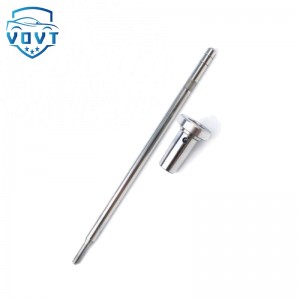High Precision New Diesel Injector Control Valve F00RJ01683 Valve Assembly for Fuel Injector Engine Spare Parts
Products Description
| Reference Codes | F00RJ01683 |
| Application | / |
| MOQ | 6 PCS |
| Certification | ISO9001 |
| Place of Origin | China |
| Packaging | Neutral packing |
| Quality Control | 100% tested before shipment |
| Lead time | 7~10 working days |
| Payment | T/T, L/C, Paypal, Western Union, MoneyGram or as your requirement |
Erosion Mechanism and Anti-Erosion Material Research for Valve Assemblies in High-Pressure Fuel Systems
Abstract:
Valve assemblies in high-pressure fuel systems are subjected to repeated impact by high-velocity fuel jets, cavitation collapse, and particle impingement, leading to progressive material loss and performance degradation. Erosion not only affects the sealing performance and response accuracy of the valve but also shortens the service life of the entire injector or pump. To address these challenges, this study investigates the erosion mechanism and evaluates anti-erosion materials for valve components under realistic working conditions of diesel injection systems.
A combined computational–experimental approach was employed. The erosion process was first simulated using computational fluid dynamics (CFD) coupled with particle tracking to analyze flow acceleration, impact angles, and cavitation distribution within the valve seat and orifice regions. The results reveal that flow separation and pressure recovery zones near the seat edge generate local jet velocities exceeding 250 m/s, which are the primary cause of micro-pitting and material fatigue. Cavitation collapse near the boundary intensifies erosion by producing transient pressures above 300 MPa.
To evaluate material performance, comparative erosion tests were conducted on several candidate materials, including hardened stainless steel (17-4PH), tungsten carbide (WC-Co), TiAlN-coated steel, and cermet-based composites. A high-pressure jet erosion test rig was used to simulate real operating conditions, with particle-laden fuel impacting samples at angles between 30° and 90°. The mass loss rate, surface morphology, and microstructure evolution were analyzed using SEM, EDS, and 3D profilometry.
The results indicate that WC-Co and TiAlN-coated materials exhibit the best erosion resistance, with erosion rates reduced by more than 60% compared to 17-4PH steel. The primary erosion mechanism transitions from ductile cutting and fatigue spalling in metallic materials to brittle fracture and coating delamination in hard coatings. Surface hardness, adhesion strength, and residual stress distribution were identified as key parameters influencing erosion behavior.
Based on the findings, a material selection and surface treatment strategy is proposed for valve assemblies to enhance erosion resistance without compromising magnetic or sealing performance. This research provides a theoretical and experimental foundation for the design of long-life, high-reliability valves in next-generation high-pressure fuel injection systems.



























